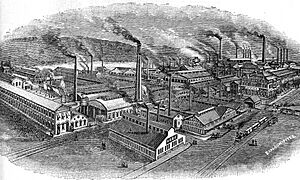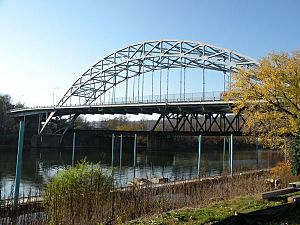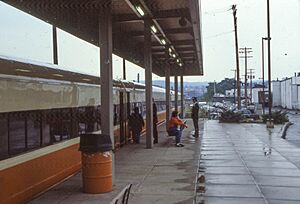McKeesport, Pennsylvania facts for kids
Quick facts for kids
McKeesport, Pennsylvania
|
|||
|---|---|---|---|
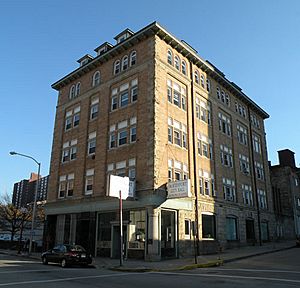
McKeesport City Hall, built c. 1890
|
|||
|
|||
| Nickname(s):
Tube City
|
|||
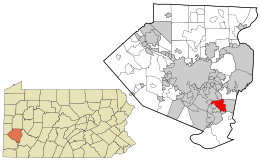
Location of McKeesport in Allegheny County, Pennsylvania (right) and of Allegheny County in Pennsylvania (left)
|
|||
| Country | United States | ||
| State | Pennsylvania | ||
| County | Allegheny | ||
| Settled | 1795 | ||
| Incorporated (borough) | September 3, 1842 | ||
| Incorporated (city) | January 15, 1891 | ||
| Founded by | John McKee | ||
| Area | |||
| • Total | 5.44 sq mi (14.10 km2) | ||
| • Land | 5.05 sq mi (13.08 km2) | ||
| • Water | 0.40 sq mi (1.02 km2) | ||
| Elevation | 760 ft (230 m) | ||
| Population
(2020)
|
|||
| • Total | 17,727 | ||
| • Density | 3,510.99/sq mi (1,355.48/km2) | ||
| Time zone | UTC-5 (EST) | ||
| • Summer (DST) | UTC-4 (EDT) | ||
| Zip Code |
15132
|
||
| Area Code | 412 | ||
| FIPS code | 42-46256 | ||
| Waterways | |||
| Transit | Pittsburgh Regional Transit | ||
McKeesport is a city in Allegheny County, Pennsylvania, United States. It's a suburb of Pittsburgh. The city is located where the Monongahela and Youghiogheny rivers meet. In 2020, about 17,727 people lived there.
Contents
History of McKeesport
Early Beginnings
The first permanent white settler in the area was David McKee from Scotland. He arrived in 1755 at the spot where the Monongahela and Youghiogheny Rivers join. This is where McKeesport is today.
Around the time of the French and Indian Wars, George Washington often visited his friend, Queen Alliquippa. She was a Seneca Indian leader. In 1769, David McKee was given the special right to run a ferry service across these rivers. This place was then called "McKee's Port."
David's son, John McKee, had a log cabin here. He took over the ferry business from his father. In 1795, John planned to create a city called McKee's Port. He advertised his idea in the Pittsburgh Gazette. New residents could buy plots of land for $20.00. A lottery was used to give out the plots fairly.
Growth in the 1800s
McKeesport started to grow in 1830. This was when people began mining the large amounts of bituminous coal found nearby. The first schoolhouse was built in 1832. James E. Huey was the first teacher.
McKeesport became a borough in 1842. A steel mill, the city's first, opened in 1851. The National Tube Works opened in 1872. After this, McKeesport became the fastest-growing city in the country. Many families moved there from other parts of the United States and from countries like Italy, Germany, and Poland. Most of them worked at the National Tube Works.
The 1900s and Beyond
McKeesport became very important in the 1900s for making steel. In 1899, the National Tube Works Company joined with 20 other pipe-making companies. They formed the National Tube Company. In 1901, this company and nine other big American steel companies merged. They created U.S. Steel.
The city's population kept growing. It reached its highest point in 1940 with 55,355 people. After that, the population started to shrink. This happened because the steel industry moved away from the area.
On June 23, 1944, a strong tornado hit the southern part of McKeesport. It was an F4 tornado and killed 17 people. Many homes were destroyed or badly damaged. About 88 homes were completely ruined.
In 1947, future presidents Richard M. Nixon and John F. Kennedy met in McKeesport. They had their first debate there about labor issues.
On May 21, 1976, a huge fire happened in downtown McKeesport. It started in the "Famous Department Store." The fire destroyed seven buildings and damaged many more. About 1,000 firefighters from over 40 nearby towns came to help.
The National Tube plant closed in 1987. Other U.S. Steel plants in the Mon Valley also closed. The city is now working to rebuild these former industrial areas.
Geography and Climate
Where McKeesport Is Located
McKeesport covers about 5.4 square miles. Most of this is land, and a small part is water. The city is about 12 miles south of Pittsburgh. It's located where the Monongahela and Youghiogheny rivers meet.
The city is on the Allegheny Plateau. Downtown McKeesport is in the northwest. The southern and eastern parts of the city are mostly residential areas.
McKeesport's Weather
The weather in McKeesport has hot, humid summers. Winters are usually mild to cool. This type of weather is called a humid continental climate.
| Climate data for McKeesport, Pennsylvania | |||||||||||||
|---|---|---|---|---|---|---|---|---|---|---|---|---|---|
| Month | Jan | Feb | Mar | Apr | May | Jun | Jul | Aug | Sep | Oct | Nov | Dec | Year |
| Mean daily maximum °F (°C) | 39 (4) |
40 (4) |
51 (11) |
63 (17) |
71 (22) |
80 (27) |
84 (29) |
83 (28) |
76 (24) |
64 (18) |
53 (12) |
42 (6) |
62 (17) |
| Daily mean °F (°C) | 30 (−1) |
31 (−1) |
40 (4) |
51 (11) |
59 (15) |
68 (20) |
73 (23) |
72 (22) |
65 (18) |
53 (12) |
43 (6) |
34 (1) |
52 (11) |
| Mean daily minimum °F (°C) | 22 (−6) |
22 (−6) |
29 (−2) |
39 (4) |
47 (8) |
57 (14) |
61 (16) |
60 (16) |
53 (12) |
41 (5) |
33 (1) |
25 (−4) |
41 (5) |
| Average precipitation inches (mm) | 2.7 (69) |
2.3 (58) |
3.2 (81) |
3.2 (81) |
3.7 (94) |
3.8 (97) |
3.6 (91) |
3.3 (84) |
3 (76) |
2.3 (58) |
2.5 (64) |
2.6 (66) |
36.1 (920) |
| Source: Weatherbase | |||||||||||||
Neighboring Towns
McKeesport shares borders with several other towns. These include North Versailles, White Oak, and Versailles. Across the rivers, you can find towns like Port Vue, Glassport, and Duquesne. Bridges connect McKeesport to many of these places.
Population and People
| Historical population | |||
|---|---|---|---|
| Census | Pop. | %± | |
| 1850 | 1,392 | — | |
| 1860 | 2,166 | 55.6% | |
| 1870 | 2,523 | 16.5% | |
| 1880 | 8,212 | 225.5% | |
| 1890 | 20,741 | 152.6% | |
| 1900 | 34,227 | 65.0% | |
| 1910 | 42,694 | 24.7% | |
| 1920 | 46,781 | 9.6% | |
| 1930 | 54,632 | 16.8% | |
| 1940 | 55,355 | 1.3% | |
| 1950 | 51,502 | −7.0% | |
| 1960 | 45,489 | −11.7% | |
| 1970 | 37,977 | −16.5% | |
| 1980 | 31,012 | −18.3% | |
| 1990 | 26,016 | −16.1% | |
| 2000 | 24,040 | −7.6% | |
| 2010 | 19,731 | −17.9% | |
| 2020 | 17,727 | −10.2% | |
| Sources: | |||
McKeesport's population has changed a lot over the years. In 1940, it had over 55,000 residents. By 2010, the number had dropped to less than 20,000. This shows how the city has changed since its peak industrial times.
In 2000, there were 24,040 people living in McKeesport. The city had many different types of families and households. About 28.6% of households had children under 18. The average age of people in the city was 40 years old.
Culture and Landmarks
International Village Festival
McKeesport is home to people from many different backgrounds. To celebrate this, the city hosts an annual event called International Village. This festival started in 1960. It's one of the biggest and oldest ethnic festivals in the Pittsburgh area. You can find traditional foods from many countries, like China, Italy, Germany, and Mexico.
Places to Visit
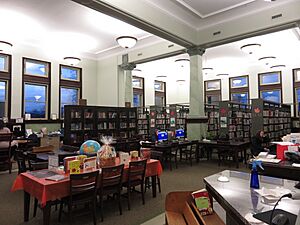
McKeesport has many interesting landmarks, including:
- Renziehausen Park Rose Garden and Arboretum
- McKeesport Regional History & Heritage Center
- Penn State University – Greater Allegheny Campus
- McKeesport Area High School
- Great Allegheny Passage Trail
- Steel Valley Trail
- Youghiogheny River Trail
- St Mary's German Church
- First Methodist Episcopal Church of McKeesport
- Carnegie Free Library
- Jerome Street Bridge
- McKeesport Marina
- McKeesport National Bank
- Dead Man's Hollow
Transportation in McKeesport
Several important roads run through McKeesport. Pennsylvania Route 148 goes through downtown. The Yellow Belt also follows Route 148. McKeesport is connected to Route 837 by the McKeesport-Duquesne Bridge. This bridge provides a direct way to get to Pittsburgh.
The city is also a starting point for the CSX Pittsburgh Subdivision railway. It is also served by the Transtar Union Railroad.
For public transport, McKeesport uses the Pittsburgh Regional Transit bus system. The McKeesport Transportation Center is the main place for buses. It was updated in 2017.
Famous People from McKeesport
Many notable people have come from McKeesport. Here are some of them:
Academia
- George E. Marcus, an expert in anthropology
- Sherman Mellinkoff, a former dean of the UCLA School of Medicine
- Merrill Singer, an anthropologist
- Herbert Spiegel, a psychiatrist known for his work on hypnosis
Actors and Broadcasters
- Grover Dale, an actor, dancer, and director
- Aline MacMahon, an Oscar-nominated actress
- Tamara Tunie, an actress and singer
- Richard Wilson, a screenwriter and director
Business and Industry
- Raymond J. Lane, a business leader at GreatPoint Ventures and former president of Oracle Corporation
- Helen Richey, the first woman to pilot a commercial airliner
- Robert J. Stevens, a former chairman and CEO of Lockheed Martin
- Emily E. Tassey, a 19th-century inventor with patents for marine propulsion
Military
- Donald M. Carpenter, an aviator in the U.S. Navy
- Franklin J. Phillips, a U.S. Marine and Medal of Honor recipient
Musicians and Artists
- Sheila Butler, a visual artist
- Byron Janis, a famous pianist
- Henrietta Leaver, Miss America 1935
- Duane Michals, a photographer
- Sam Sneed, a music producer and rapper
- Jerry Tachoir, a jazz vibraphone and marimba player
- Mort Weiss, a jazz clarinet player
Sports
Auto Racing
- Tommy Gale, a NASCAR driver in the 1970s and 1980s
Baseball
- Tim Conroy, a former Major League Baseball pitcher
- Brian Holton, a former MLB relief pitcher
- Rick Krivda, an MLB pitcher and Olympic gold medalist
- Tom Qualters, a former MLB pitcher
- Bill Robinson, a former MLB outfielder and coach
- Gary Ross, a former MLB pitcher
Basketball
- Swin Cash, a WNBA player and Olympic Gold Medalist
Bullfighting
- Bette Ford, the first American bullfighter to fight in Plaza Mexico
Football
- Jim Beirne, a former AFL/NFL wide receiver
- Ron Crosby, an NFL and USFL player
- Dave Gasser, a former Canadian Football League linebacker
- Khaleke Hudson, an NFL Linebacker for the Washington Commanders
- Branden Jackson, an NFL Defensive End
- Jim Kelly, a former Notre Dame and NFL tight end
- Maurice Leggett, a former Kansas City Chiefs cornerback
- Mike Logan, a former Pittsburgh Steelers safety
- Bob Long, a former NFL wide receiver
- Bill Miller, a former AFL wide receiver
- George Mrkonic, a football player for the University of Kansas
- Greg Paterra, an NFL player
- Brandon Short, a former NFL linebacker
- Russell Stuvaints, a former NFL defensive back
- Jim Trimble, a former NFL and CFL head football coach
Politicians and Government Leaders
- Queen Alliquippa, a Seneca tribe leader
- Frank Buchanan, a former mayor of McKeesport and U.S. Representative
- Vera Buchanan, a former U.S. Representative
- William Henry Coleman, a former U.S. Representative
- Marc Gergely, a Pennsylvania state representative
- John E. McLaughlin, a former Deputy Director of Central Intelligence
- Emil Mrkonic, a former Pennsylvania House of Representatives member
- Bill Shuster, a U.S. Representative
- Al Benedict, Pennsylvania Auditor General
- Nicholas P. Papadakos, a Justice on the Pennsylvania Supreme Court
- Austin Davis, Lieutenant Governor of Pennsylvania
Writers
- Bob Carroll, Jr., a television screenwriter known for I Love Lucy
- Marc Connelly, a playwright
- John Hoerr, a journalist and author
- David Kalstone, a writer and literary critic
- Robert M. McBride, a writer and publisher
- Miles S. Richards, a historian and author
See also
 In Spanish: McKeesport para niños
In Spanish: McKeesport para niños





